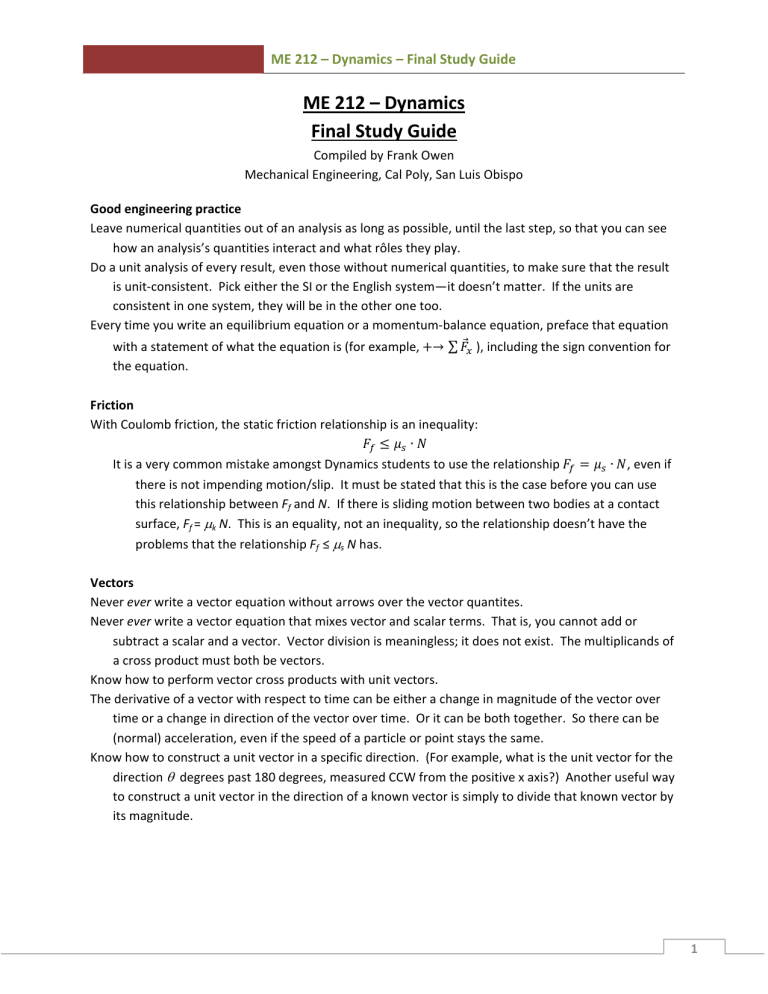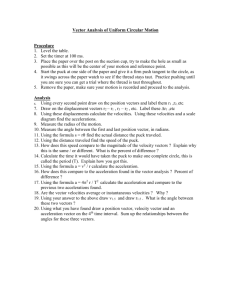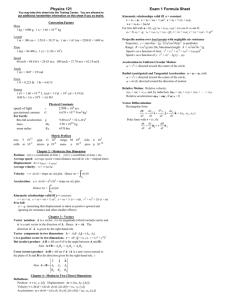ME 212 – Dynamics Final Study Guide

ME 212 – Dynamics – Final Study Guide
ME 212 – Dynamics
Final Study Guide
Compiled by Frank Owen
Mechanical Engineering, Cal Poly, San Luis Obispo
Good engineering practice
Leave numerical quantities out of an analysis as long as possible, until the last step, so that you can see how an analysis’s quantities interact and what rôles they play.
Do a unit analysis of every result, even those without numerical quantities, to make sure that the result is unit ‐ consistent.
Pick either the SI or the English system—it doesn’t matter.
If the units are consistent in one system, they will be in the other one too.
Every time you write an equilibrium equation or a momentum ‐ balance equation, preface that equation with a statement of what the equation is (for example, → ∑ ), including the sign convention for the equation.
Friction
With Coulomb friction, the static friction relationship is an inequality:
∙
It is a very common mistake amongst Dynamics students to use the relationship ∙ , even if there is not impending motion/slip.
It must be stated that this is the case before you can use
Vectors this relationship between F f
and N .
If there is sliding motion between two bodies at a contact surface, F f
=
k
N .
This is an equality, not an inequality, so the relationship doesn’t have the problems that the relationship F f
≤
s
N has.
Never ever write a vector equation without arrows over the vector quantites.
Never ever write a vector equation that mixes vector and scalar terms.
That is, you cannot add or subtract a scalar and a vector.
Vector division is meaningless; it does not exist.
The multiplicands of a cross product must both be vectors.
Know how to perform vector cross products with unit vectors.
The derivative of a vector with respect to time can be either a change in magnitude of the vector over time or a change in direction of the vector over time.
Or it can be both together.
So there can be
(normal) acceleration, even if the speed of a particle or point stays the same.
Know how to construct a unit vector in a specific direction.
(For example, what is the unit vector for the direction
degrees past 180 degrees, measured CCW from the positive x axis?) Another useful way to construct a unit vector in the direction of a known vector is simply to divide that known vector by its magnitude.
1
ME 212 –
Particle kinematics
Rectilinear motion
and ; from these come
Dynamics – Final Study
∙ and
Guide
∙ .
Know how to
If a set up these definite integrals, their limits of integration, and then how to do the integration.
For the above integrals, need and to perform the integration.
is constant, ∙ , and ∙ ∙ .
There is also the funny relationship ∙ ∙ .
This can be used if a is constant, if a = a ( x ), if v = v ( x ), if a = a ( v ).
In all of these cases, collect functions of like variables on one side of the equation and integrate them using the proper integration limits.
Planar motion
Cartesian coordinates ( x / y ) – Projectile motion: constant acceleration in the y direction ( a y
= ‐ g ) and a x
= 0.
Polar coordinates ( r /
) – I like the derivation of the expression for in polar coordinates.
One starts with the displacement vector ∙ ̂ and uses the product rule and some drawings to get in polar coordinates.
The rules of differentiation yield Coriolis acceleration, for example.
Path coordinates ( n / t ) – Velocity always in t direction.
Acceleration in t direction represents increasing or decreasing speed.
Acceleration in the n direction represents a change in direction of the velocity vector.
So in a car, the accelerator and the brake are the controls.
But the steering wheel is an accelerator too.
It’s the control.
Particle kinetics
N2L
FBD=MAD – Start with this equation, then draw the diagrams, leaving out any part of the environment touching the object being analyzed.
W/E
A hint to use W/E on a kinetics problem is if a situation is described with distances covered between two end states.
→
Don’t calculate the work of gravity or a spring.
Account for these changes in energy state as ∆ and
∆
.
Be able to make power calculations too.
∙
,
∙
.
I/M
A hint to use I/M on a kinetics problem is if a situation is described with elapsed time given between two end states or if beginning and end v s or
s are given or sought.
Linear and angular momentum conserved if
F or
M =0.
Angular momentum of a particle about a point is just moment of linear momentum about that point.
Without spatial extension,
0
.
2
ME 212 – Dynamics – Final Study Guide
e = 0 is plastic impact, so bodies stick together ( )
e = 1 is elastic impact.
Energy is conserved during impact.
Impact
Impact defines n and t directions.
For non ‐ rough impact (all that we covered), no impulse forces in tangential direction.
So no change in pre ‐ and post impact tangential velocities.
Change in normal velocities depends on coefficient of restitution ( e ).
Rigid ‐ body kinematics
Rotary analogues to 1 ‐ D motion
and ; from these come ∙ and ∙ .
If is constant, the constant ‐ acceleration relationships are analogous to the case of 1 ‐ D motion.
There is also the funny relationship ∙ ∙ and all the interesting variations of integration that go with it (see “Rectilinear motion” above).
Relative motion
Know why you write the subscript of
AB
and
AB
without a “/” and why v
A/B
and a
A/B
have a “/”.
Know what the “/” means.
If a body is “released from rest”, it is not rotating, so there are no normal accelerations (see Pledge of Allegiance below).
On a rigid body, there is only tangential velocity between any two points—A and B.
B cannot approach A, nor can it recede from A.
The distance between A and B never changes.
If the reference point is A, then on a rotating body AB, it looks to an observer on A that point B is just moving left or right.
It looks as if B is rotating around A.
Even though B cannot approach A, it can accelerate toward A.
This is just the normal acceleration of circular motion toward the apparent center of rotation.
So
/
always points from B to A.
For relative velocity and relative acceleration, I really recommend using velocity and acceleration diagrams to graphically illustrate the vector sums
/
and
/ /
.
Know a mechanism, like a 4 ‐ bar or a slider ‐ crank real well.
Knowing one well carries over to other mechanisms.
The Pledge of Allegiance
/
/
/
/
/ / /
/ /
/ /
This is true for any two points on a rigid body in general plane motion.
3
ME 212 – Dynamics – Final Study Guide
Rigid ‐ body kinetics
is radius of gyration about center of mass.
It gives :
.
N2L other than the center of mass, and such a
∙ .
k can be given about points
See particle N2L.
On the MAD, draw all vectors and at the center of mass.
To sum moments, if the problem is to find accelerations at the instant shown (often a release from rest), you can sum moments about any point.
Choose a point strategically, to eliminate as many unknown forces as possible from the moment equilibrium equation.
W/E
If multiple bodies constrained to move together, just take the total energy of each “before”, the
I/M total work done on them or by them (usually friction) during the motion, and then the total energy of each “after”.
Be able to draw a momentum diagram and write the momentum balance for a problem.
Draw all s and s of and at the center of mass.
Impulse part of diagram will have all forces and moments integrated by t .
Preface all equations related to momentum diagram with
∑
,
∑
,
∑
to show what you are doing and include sign convention.
Impact
Use momentum diagram for these analyses.
The relationship for e is the same, but the velocities in the formula apply to the velocities of each body at the point of impact (POI).
If a body strikes an immovable barrier, probably don’t know direction of impact force from obstacle onto body, so probably will sum momentum moments about the POI to eliminate the contact force from the I/M equation.
4






